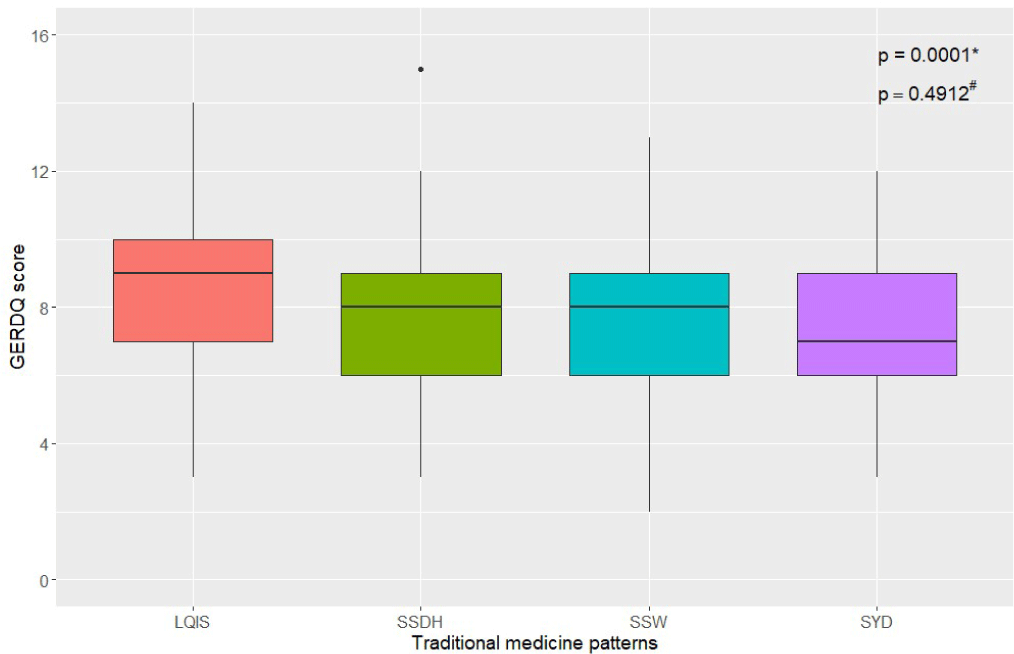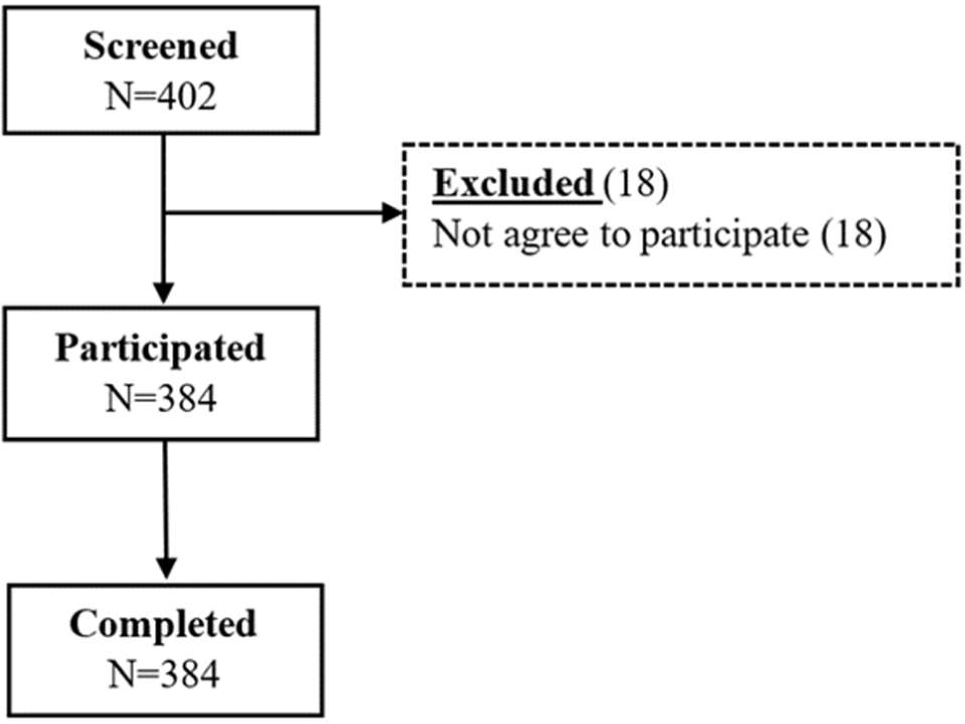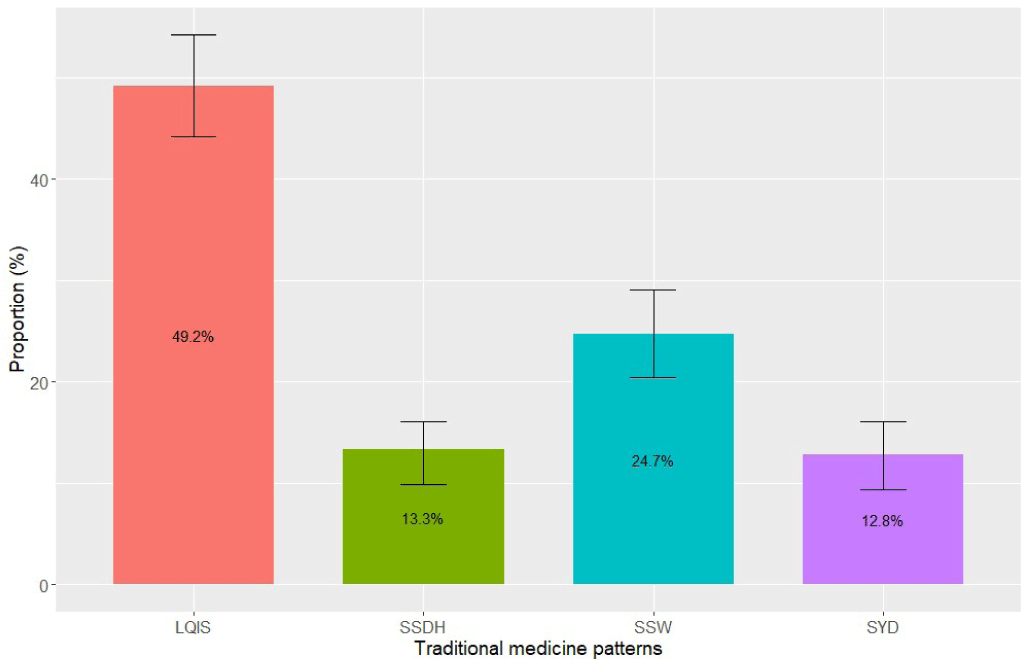1. INTRODUCTION
Gastroesophageal reflux disease (GERD) is a very common disease nowadays. In Vietnam in 2021, GERD accounted for about 26% of cases presenting with gastrointestinal symptoms [1]. In Western medicine, the diagnosis of GERD is primarily based on the clinician’s clinical expertise or the use of the Gastroesophageal Reflux Disease Questionnaire (GERDQ) to assess the severity and diagnosis of GERD [2]. As for treatment, currently, although proton pump inhibitors had been considered the main treatment for GERD in Western medicine with certain effectiveness, the completeness of treatment was still incomplete for approximately 40% of patients were resistant to standard doses [3]. Therefore, the demand for traditional medicine (TM) treatment for this disease was increasing, so the diagnosis of TM patterns was very important to get effective treatment [4,5]. For that reason, the epidemiological and pathological information of TM played a very important role in helping to guide clinics and research on the treatment of this pathology.
Meanwhile, in Vietnam, the prevalence of GERD in TM has yet to be documented. Therefore, the present study aimed to survey a population of GERD patients to assess the prevalence of TM patterns and their relationship with the severity of GERD, as indicated by GERDQ scores. The findings of this study are expected to provide a foundation for further clinical practice in the field of TM for GERD management.
2. METHOD
A cross-sectional study was performed on outpatients who met inclusion criteria including the age of 18 years or older and being diagnosed with GERD by the gastroenterologist. The patients excluded were the ones not healthy enough to conduct interviews and did not complete the survey. The study was performed following the STROBE and CROSS guidelines [6,7].
Since no previous studies used these diagnostic criteria to survey the proportions of patterns, we used p=0.5 to obtain the largest sample size. The formula to calculate the sample size was:
N was desired sample size; α was type-I error; ; was critical value and a standard value for the corresponding level of confidence (at 95% CI or 5% level of significance (type-I error) it was 1.96); p was expected prevalence; d was the margin of error or precision [8].
The convenience sampling technique was used until the necessary sample size was achieved.
General Information variables included age, sex, occupation, body mass index (BMI), and disease duration. Survey information includes 4 patterns taken from Pattern Identification of Gastroesophageal Reflux Disease (PIGERD) and GERDQ score calculated based on GERDQ [9,10].
PIGERD tool is a result of the study by Han et al., which is a questionnaire developed based on a survey of Traditional Chinese Medicine and Korean Medicine literature, and the opinions of TM experts [9]. The questionnaire consists of four TM patterns, including Liver qi invading the Stomach (LQIS) with 14 symptoms and signs, Spleen-Stomach dampness-heat (SSDH) with 13 symptoms and signs, Spleen-Stomach weakness (SSW) with 11 symptoms and signs, and Stomach yin deficiency (SYD) with 11 symptoms and signs. Each symptom and sign is scored based on its severity using a five-point Likert scale (0-4): from 0 (absent) to 4 (always). Each symptom or sign is given a certain coefficient. Their scores are calculated by multiplying their severity score and respective coefficients. The score of each pattern is equal to the sum of the score of all symptoms and signs of that corresponding pattern. After scoring, the patient is classified into the TM pattern with the highest score. The medical terms used in PIGERD are defined by the World Health Organization’s international standard terminologies [11,12].
We had the Korean version translated into Vietnamese by one interpreter, and then another interpreter would translate the Vietnamese version back into Korean, with the two translations being compared until they matched. However, this questionnaire was not pretested and we had not assessed its validity and reliability.
The severity of GERD was evaluated using the GERDQ, which consists of six items recording the frequency of symptoms and over-the-counter (OTC) medication use over seven days. The questionnaire employs a four-point Likert scale (0-3) to assess four positive GERD symptoms (heartburn, regurgitation, sleep disturbance due to reflux symptoms, and use of OTC medications for reflux symptoms), and a reversed four-point Likert scale (3-0) to assess two negative GERD symptoms (epigastric pain and nausea). The GERDQ score ranges from 0 to 18, with a higher score indicating a more severe condition [10].
The survey was performed at the Gastroenterology clinic of the University Medical Center Ho Chi Minh City (UMC) from December 2021 to May 2022. After the patients completed their appointment, we approached and then selected the ones who met the inclusion criteria and did not meet the exclusion criteria. If the patients agreed to participate, they would be interviewed and examined directly by the investigator according to the survey form. The survey time was from 15 to 20 minutes and each participant was surveyed only once. The investigator interviewed and examined the participants directly according to the checklist in the survey form, then recorded the results of the variables. To prevent the “multiple participation” of participants, each participant would have a hospital medical record code to identify duplicates.
Age was the variable calculated as the current year minus the patient’s year of birth. Sex was the variable that included Male and Female. Age and sex were based on the patient’s national identity card. Occupation with three groups included manual labor, intellectual labor, and no labor. BMI was calculated based on weight and height and classified based on the Asia-Pacific classification of BMI [11]. Disease duration was calculated from the date the patient had symptoms of GERD or from the time they were diagnosed with GERD until being surveyed.
The TM pattern was a categorical variable with four values including LQIS, SSW, SSDH, and SYD. These values were established based on the PIGERD tool [9].
The GERDQ score was a numeric variable calculated based on the GERDQ tool, with a minimum value of 0 points and a maximum value of 18 points [10].
In this study, the data were processed using Microsoft Excel 365, and there was no missing data. The variables, namely age, BMI, disease duration, and GERDQ were presented using either mean with standard deviation (SD) or median with interquartile range (IQR), depending on the distribution characteristics of the data. In addition, the variables sex, occupation, overweight, obesity, and TM patterns were presented using frequency with a percentage (%), and with a 95% confidence interval (CI) for TM pattern outcomes. The difference in GERDQ scores across different TM patterns was tested using the Kruskal-Wallis test and the significance level was set as a p-value of less than 0.05. Analyses were done using the statistical software R version 4.1.0.
3. RESULTS
From December 2021 to May 2022, we approached 402 patients. 384 patients who met the inclusion criteria and did not meet the exclusion criteria had been recruited. Out of the 18 patients who were not recruited, 5 declined to participate without providing any reason, while 13 declined due to a lack of time to complete the survey (Figure 1).
The majority of participants in this study were female, accounting for 67.7% of the total sample. The average age of the 384 surveyed patients was 45.5 ± 14.0 years. The age range varied from 18 to 76 years, with the oldest participant being 76 years old and the youngest being 18 years old. Regarding occupation, the manual, intellectual, and non-labor worker groups constituted a similar proportion, collectively representing approximately one-third of the total participants. The mean body mass index (BMI) of the patients was 22.0 ± 3.0 kg/m2. According to the Asia-Pacific classification of BMI, a notable proportion of patients (37.7%) fell into the overweight and obesity class 1 and class 2 categories. The median duration of the disease among the participants was 12 months. On average, the participants scored 8.1 ± 2.5 on the GERDQ. The majority of participants scored above the cutoff point of 8 (Table 1).
Among the 384 surveyed GERD patients, the predominant TM pattern was LQIS, observed in 189 patients (49.2%), constituting approximately half of the total surveyed population. SSW pattern ranked second with 95 patients (24.7%), representing nearly a quarter of the surveyed patients. The remaining two patterns, SSDH and SYD, were observed in 51 patients (13.3%) and 49 patients (12.8%), respectively. These findings are presented in Figure 2.
In this study, we assessed the GERDQ score in patients diagnosed with TM patterns based on the PIGERD tool (Figure 3). When comparing the GERDQ scores among the four TM patterns using the Kruskal-Wallis test, we observed that the GERDQ score for the LQIS pattern (median [IQR] of 9 [7, 10]) was significantly higher than the scores for the other three TM patterns (p = 0.0001). However, there was no significant difference in GERDQ scores among the SSDH, SSW, and SYD patterns, with median scores of 8 (6, 9), 8 (6, 9), and 7 (6, 9), respectively (p > 0.05).

4. DISCUSSION
Of the 384 GERD patients surveyed, women accounted for about two-thirds of the surveyed patients. Research on GERD conducted by Quach et al. also at University Medical Center Ho Chi Minh City also showed that the male-to-female ratio was 1:3. This ratio shows a similarity, as women account for a high proportion of GERD [13]. The average age of the surveyed patients is 45.5 ± 14.0 years old. Compared with Quach’s study on GERD in 2021, which was 43.2 ± 11.8, the average age of the study sample was higher, but still in middle age [1]. The proportion of occupations of the patients is similar, showing that GERD occurs equally in all subjects, appearing in all occupations regardless of manual or intellectual labor and in non-working people. The mean BMI of the whole group was at the average level according to the Asia-Pacific classification of BMI but the proportion of overweight, obesity class 1, and obesity class 2 was quite high (37.7%), which is very appropriate when overweight or obesity is closely related to GERD. Obesity is also a major factor in the increased incidence of GERD in Asia [14], and obesity people are nearly three times more likely to have GERD than people of normal weight [15]. The disease duration in the surveyed group focused mainly from 1 month to 18 months, showing that the majority of patients had come for treatment when the disease had just started. This partly reflects the great need for GERD treatment because GERD greatly affects the quality of life.
In 384 patients, LQIS is the most common TM pattern, accounting for up to half of all patients. This result has similarities with studies on TCM pathology in this pathology conducted in previous studies. For example, a study by Sun et al. conducted on 260 GERD patients, reported that Liver-Stomach compressed-heat pattern is the TM pattern with the highest proportion in GERD with 87.2% [16]. A study by Zhou et al. recorded that the Liver qi stagnation pattern appeared in GERD up to 41% [17]. The two studies above used different diagnostic questionnaires, so some medical terms were different from the PIGERD questionnaire. However, in terms of mechanism, Liver-Stomach compressed heat or Liver qi stagnation were both mechanical conditions of the Liver in TM that are not secreted, so they can cause stagnation to generate heat. Compared with our study, these two results are similar, showing that the condition of Liver qi, which affects the Spleen and Stomach, was the most common condition in GERD.
Through the survey, it was found that GERD has many different patterns, so to increase the scientificity of TM studies, we suggest that need to pay more attention to classifying patterns in clinical treatment as well as do this in GERD treatment studies with TM to get effective results. Besides, studies should also focus on LQIS most because this is the pattern with the highest proportion in this disease.
A cross-sectional study conducted by Quach et al. also at University Medical Center Ho Chi Minh City showed that the GERDQ cut-off point was 6 points for sensitivity and specificity in diagnosing GERD, respectively 70.3% and 72% [13]. This shows that the cut-off point of the total GERDQ score for diagnosing GERD in Vietnam is lower than that in the West because the Western cut-off point is 8 points with a sensitivity of 64.6% and a specificity of 71.4% [2]. It has been explained that GERD patients in Vietnam often have epigastric pain and this symptom was a negative predictive symptom of GERDQ. The presence of this symptom would lower the GERDQ score. Although the proportion of epigastric pain in our study was also quite high, the mean GERDQ score in our study was 8.1 ± 2.5, equivalent to the Western cut-off point, higher than previous surveys conducted in Vietnam. This may be because the GERD patients surveyed had positive predictive symptoms such as heartburn and regurgitation that appeared very strongly, leading to a significant increase in the total GERDQ score.
The LQIS pattern exhibited the highest GERDQ score of 9 (7, 10), which was significantly greater than the other three TM patterns. These findings suggest that LQIS is a prominent manifestation of GERD and indicative of a more severe form of the disease. Notably, heartburn and regurgitation were prevalent among the surveyed patients and are regarded as hallmark symptoms of GERD. The PIGERD questionnaire scored these symptoms for the LQIS pattern, which may account for the elevated GERDQ scores associated with LQIS.
This study was the first of its kind in Vietnam to investigate the prevalence of TM patterns in GERD. It aimed to aid clinicians in the diagnostic process and identify the dominant clinical TM pattern in this disease.
However, there are several limitations to consider. Firstly, the external validity of the results may be limited due to the study’s focus on a single center, the UMC. While the sample characteristics closely resemble those of GERD patients at this center, caution should be exercised when generalizing the findings to other populations or communities. Secondly, the survey was not pretested, and the validity and reliability were not assessed. Lastly, the reliance on a single investigator to examine patients once may introduce biases such as observer bias, inter-rater variability, sampling bias, recall bias, and the inability to capture time-dependent changes in patients’ conditions. To address the limitations in future studies, it is recommended to conduct multicenter surveys to enhance generalizability and include multiple investigators to minimize inter-rater variability. Additionally, pretesting the survey instrument and assessing validity and reliability should be prioritized to ensure the accuracy and trustworthiness of the collected data.
Conclusion
In summary, our study revealed that LQIS was the most common TM pattern in GERD patients, while the remaining patients were distributed among the SSW, SSDH, and SYD patterns. Importantly, LQIS was also associated with the highest severity. These findings provide valuable insights into the relationship between GERD and TM patterns and highlight the importance of considering TM patterns in the management of GERD. Well-designed multicenter studies should be conducted to confirm these findings. Additionally, investigating the influence of lifestyle factors, including stress, physical activity, and diet, on GERD symptoms and TM patterns could offer valuable insights into their roles in the development and severity of GERD.











